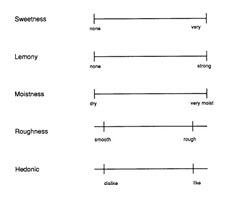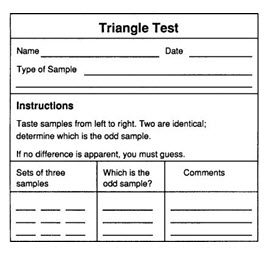Site pages
Current course
Participants
General
Module- 1 Engineering Properties of Biological Mat...
Module- 2 Physical Properties of Biomaterials
Module- 3 Engineering Properties
Module- 4 Rheological Properties of Biomaterials
Module- 5 Food Quality
Module- 6 Food Sampling
Module- 7 Sensory quality
Module 8. Quality Control and Management
Module 9. Food Laws
Module 10. Standards and regulations in food quali...
Lesson 32. Sanitation in food industry
Lesson 23. Methods of Sensory Evaluation
23.1 Introduction
Instruments can be set for values and calibration points. Sensory attributes are complex and hence, a more varies approach is required. Sensory responses can be measured by various ways and sensory data usually fall under one these categories.
Nominal data: the items examined are placed in two or more groups which differ in name but do not obey any particular order or any quantitative relationship; example: the numbers carried by sports players.
Ordinal data: the panelist places the items examined into two or more groups which belong to an ordered series; example: slight, moderate, strong.
Interval data: panelists place the items into numbered groups separated by a constant interval; example: three, four, five, six.
Ratio data: Panelists use numbers which indicate how many times the stimulus in question is stronger (or saltier, or more irritating) than a reference stimulus presented earlier.
Nominal data contain the least information. Ordinal data carry more information and can be analyzed by most nonparametric statistical tests. Interval and ratio data are even better because they can be analyzed by all nonparametric and often by parametric methods. Ratio data are preferred by some because they are free from end-of-scale distortions.

23.2 Methods of Measuring Responses
23.2.1 Classification:
In classification tests, the subjects are asked to select an attribute or attributes which describe the stimulus. In a beverage test, for example, subjects place a mark next to the term(s) which best describe(s) the sample:
No attempt is made to standardize the terms, and the results are reported as the number of check marks for each term. Such data are nominal: no numbers are used, and there is no increasing or decreasing series expressed in the data. For example, the apples in a lot may be characterized by predominant color (red, green, yellow). Selection of the terms for classification must be based on actual product characteristics. This in turn requires pre examination of the samples by a well-trained panel to make sure that all appropriate attributes are listed.
Grading: Various commodities can be segregated on the basis of specified qualities with the help of expert graders. Coffee, Tea, Spices, Fish, Meat etc are graded on the basis of overall attributes giving a grade : Extra, Regular, Reject etc.
Ranking: Ranking tests are rapid and can be performed with relatively little training and familiarization with the attribute under test. Ranking tests have wide application, but with sample sets above three they do not discriminate well compared to scaling tests.
Scaling: Scaling techniques involve the use of numbers or words to express the intensity of a perceived attribute (sweetness, hardness, smoothness) or a reaction to such attribute (e.g., too soft, just right, too hard). If words are used, the analyst may assign numerical values to the words (e.g., like extremely = 9, dislike extremely = 1) so that the data can be treated statistically. Compared with difference testing, scaling is a more informative and therefore a more useful form of recording the intensity of perception. As with ranking, the results are critically dependent on how well the panelists have been familiarized with the attribute under test and with the scale being used.

Fig: Line Scale
23.2.2. EVALUATION CARD
The questionnaire or score card should be prepared carefully for each test. The card should be clearly typed or printed. It should be simple and use unambiguous terms and directions in the desired sequence of action as a guide to the evaluation.
The design of score cards for sensory evaluation is challenging and difficult because the key characteristics of the product need to be evaluated on paper in a way that permits the judges to transmit their assessments of the samples accurately to the researcher. A score card with too much detail and clutter may discourage careful judgement too brief a form may fail to obtain some important information.
A score card may be as simple as indicating which sample is different as is done when duo-trio or triangle testing is the mode being used. A sheet for indicating rank order for a single characteristic also is extremely simple. It is in the descriptive tests that the score card becomes a critical part of the planning for an experiment.
A table utilising the hedonic ratings ranging from unacceptable to very acceptable is relatively easy to construct. No single score card fits all experiments. Instead, the score card needs to be developed for the specific experiment. All score cards should contain the date and name of the judge.
23.3 Sensory Methods:
Following sensory tests are used on different conditions.
Difference or Discriminative tests
Scoring
Ranking
Hedonic scale
Descriptive analysis
Acceptance and preference test
23.3.1 Difference or Discriminative Testing.
Difference test is one of the most useful sensory tests. It is generally used for selection and training of sensory panelists. Difference test is designed to discriminate difference between two or more samples. Within this general class are a variety of specific methods, viz., paired comparison, duo-trio, triangle and multiple sample tests. The main features of these difference tests are .
a) Paired Comparison Test: It is a two products (A & B) test, and the panelist’s job is to compare these and identify whether the samples are similar of different. If different, which attribute, such as sweetness, acidity, hardness, colour etc. is responsible for this difference. This part of the test is called as directional difference test. The test can be further extended and the preference component of the panelist can be included. The paired comparison test is relatively easy to organize and implement. The two coded samples in order of AA, BB, AB, BA are served simultaneously, and panelist has to decide if there is any difference or not. Paired comparison is typically used in comparing new and old processing techniques, change of ingredients in a product, preference testing at the consumer level, etc.
b) Duo-trio Test: This test is a modified paired comparison test. One sample identified as the reference (R) is first given to the panelists for evaluation. Subsequently two coded samples, one of which is identical to reference, are presented. The panelist is asked to indicate, which of the two samples is the same as ‘R’. The test is suitable for products that have relatively intense odour, taste and/or kinesthetic effects such that sensitivity of evaluator is significantly reduced. c) Triangle Test: Triangle test is most well known and more frequently used out of the three difference tests. As its name implies, it is a three product test in which all the samples are coded and the panelist’s task is to determine which two are most similar or which one is most different from the other two. Triangle test is more difficult test because the panelist must recall the sensory characteristics of two products before evaluating the third and then make a decision.

d) Multiple Sample Test: Test involving more than 3 stimuli are classified as multiple sample tests. They may have equal (symmetrical) or unequal (asymmetrical) numbers of each stimulus. When they are applied as true difference tests, the judge is required to separate the sample into two groups of like samples. When they are applied as directional tests, the judge is asked to identify the groups of higher or lower intensity of a given criterion.
23.3.2. Scoring:
Certain score is given to each sensory attribute arranged in logical order on a score sheet in this method. The weightage is given on the basis of importance of the attribute. For example, flavour is considered to be most important and highest score is allotted to this attribute. The scoring method is most extensively used by the dairy industry. Score cards wherein 10 to 100 total points have been allotted to different quality attributes are in use for dairy and food products. Scoring method is most frequently used because of its diversity, simplicity and ease of statistical analysis. The most attractive feature of this method is that rigorous training is not required for panelists as information on defects and scoring guide is also provided on the scorecard.
23.3.3. Ranking
In ranking method two or more samples are provided to the panelists who are asked to arrange them in an ascending or descending order of intensity of a specific attribute, e.g. sweetness. Ranking is often used for screening inferior from superior samples in product development. This method is also suited for comparison of market samples of different brands. Samples may be ranked in order of degree of acceptability or in order of general quality or by a specific attribute.
23.3.4 Hedonic Rating
Hedonic relates to the psychology of pleasurable and non pleasant states of consciousness. In hedonic method, psychological states of like and dislike are measured on a rating scale. Normally rating scale has been categorized into five forms, viz. numerical, graphic, standard, cumulated points and forced choice forms. The Nine points numerical scale as given below has been most extensively used for new product development and consumer studies.
|
SCORE CARD – HEDONIC SCALE Name of the Judge:____________________ Date: _____________ Product Name________________________ Attribute: ___________
|
||
|
Degree of Preference |
Sample 1 |
Sample 2 |
|
Like Very much |
|
|
|
Like much |
|
|
|
Like moderately |
|
|
|
Like slightly |
|
|
|
Neither like nor dislike |
|
|
|
Dislike slightly |
|
|
|
Dislike moderately |
|
|
|
Dislike much |
|
|
|
Dislike very much |
|
|
|
Comments |
|
|
The above scale can be modified by assigning a numerical value of 0 to the indifferent category, with positive integers above and negative integers below this point. The use of positive and negative type of scoring can be effectively used by only trained panel. The hedonic scale provides following advantages:
evaluators can respond to the queries without previous experience
data can be handled statistically, and
indicates general level of preference or liking for the samples
The only requirement for use of hedonic method is that large number of evaluators are needed to provide reliable responses or results.
23.3.5. Descriptive Analysis
Descriptive method of sensory evaluation provides quantitative descriptions of a sensory attributes of a product taking into account all sensation that are perceived: visual, auditory, olfactory, gustatory, kinesthetic and so on. A descriptive method enables us to relate specific process variables to specific changes in some of the sensory attributes of a product, for example, the flavour changes in milk at high temperature processing. A descriptive test involves relatively few judges, who have been screened, selected and trained for the particular product category. Training of this group is primarily focused on development of descriptive language, which is used as a basis for scoring a new product, developing a definition of each attribute and familiarizing the judges with scoring procedures. There are numerous applications for descriptive analysis including monitoring competitions, storage stability/shelf life, product development, quality control, establishing physical/chemical and sensory correlation. Some of the popularly used descriptive method are flavour profile, texture profile etc.
23.3.6. Acceptance/Preference Testing
Affective or acceptance testing is a sensory technique, usually performed at consumer’s levels. It refers to measuring liking or preference for a product. Preference can be measured directly by comparison of two or more products with each other. Indirect measurement of preference is achieved by determining which product has scored significantly higher rating than another product in a multi product test. The two methods most frequently used to directly measure preference and acceptance are the paired comparison test and a 9-points hedonic scale.